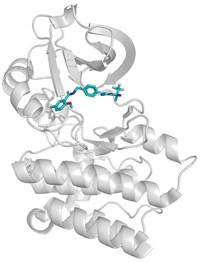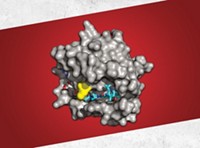Advertisement
Grab your lab coat. Let's get started
Welcome!
Welcome!
Create an account below to get 6 C&EN articles per month, receive newsletters and more - all free.
It seems this is your first time logging in online. Please enter the following information to continue.
As an ACS member you automatically get access to this site. All we need is few more details to create your reading experience.
Not you? Sign in with a different account.
Not you? Sign in with a different account.
ERROR 1
ERROR 1
ERROR 2
ERROR 2
ERROR 2
ERROR 2
ERROR 2
Password and Confirm password must match.
If you have an ACS member number, please enter it here so we can link this account to your membership. (optional)
ERROR 2
ACS values your privacy. By submitting your information, you are gaining access to C&EN and subscribing to our weekly newsletter. We use the information you provide to make your reading experience better, and we will never sell your data to third party members.
Pharmaceuticals
Crizotinib Chronicles
Pfizer’s ALK inhibitor gives hope to some lung cancer patients
by Lisa M. Jarvis
July 26, 2010
| A version of this story appeared in
Volume 88, Issue 30

Doctors are reluctant to read too much into promising results from small clinical trials of cancer drugs. No point getting excited when so often drugs don’t look as hot after being tested in a larger population. But at the American Society of Clinical Oncology’s (ASCO) annual meeting last month, a Phase I/II trial of Pfizer’s crizotinib created a lot of buzz. The drug seemed to help nearly all of the 80 lung cancer patients who took it.
Crizotinib targets ALK, a protein kinase that until a few years ago was poorly understood. But a set of fortuitous discoveries has put ALK, or anaplastic lymphoma kinase, in the drug industry’s crosshairs. Pfizer’s drug is swiftly moving toward commercialization, and other firms are exploring follow-on ALK inhibitors.
The crizotinib story begins 10 years ago at Sugen, a South San Francisco-based biotech firm that had just been acquired by Pharmacia. Sugen scientists were interested in finding an inhibitor of c-Met, a protein implicated in tumor metastasis. Scientists James Christensen and Jean Cui led the Sugen team in a medicinal chemistry campaign based on the same series of indols that yielded the firm’s kidney cancer drug Sutent.
Their work translated into the discovery of the first publicly disclosed potent c-Met inhibitor. However, the compound’s molecular weight was way too high to make it a good drug.
After determining the crystal structure of the compound bound to the c-Met protein, Sugen scientists designed a more druglike amino pyridine scaffold that became the basis for crizotinib. Around the same time, Pfizer bought Pharmacia, and several Sugen scientists, including Cui, transferred to Pfizer’s La Jolla, Calif., site, where the new compound was optimized. In 2004, the company had its drug candidate.
By 2007, crizotinib was in Phase I trials to determine its pharmacokinetic properties and tolerability. Pfizer, meanwhile, was considering what types of tumors could be taken down by a c-Met inhibitor (C&EN, Aug. 20, 2007, page 15).
Then, a set of discoveries changed the course of the drug’s development. Researchers led by Hiroyuki Mano, a professor of functional genomics at Japan’s Jichi Medical University, found that when a certain chromosome inverted, a fusion occurred in lung cancer cells between the echinoderm microtubule-associated proteinlike 4 (EML4) gene and the ALK gene. The researchers found that the fusion caused tumor formation in mice. A subsequent test determined that about 7% of lung cancer patients had this fusion gene. In a paper published in Nature, the researchers concluded that ALK would make a good drug target (Nature 2007, 448, 561).
As it happened, Pfizer had just learned it had an ALK inhibitor on its hands. The company and Massachusetts General Hospital had evaluated results from large biochemical and cell-based screens to see whether crizotinib was hitting targets other than c-Met, says Christensen, who is now director of translational research in Pfizer’s oncology unit. Upon characterizing the hits, the collaborators found that it was blocking ALK’s activity.
In fact, the drug appeared to be almost as potent against ALK as it was against c-Met, Cui says. At first blush, the dual activity was puzzling, because the kinases have few structural similarities. But crizotinib’s activity appears to be related to an interaction with one particular tyrosine within one of the three phosphorylation sites—the activation loop—on the c-Met protein. “At the same position, ALK has this same residue,” Cui explains. “We think that probably contributes to the cellular potency.”
Scientists are no strangers to serendipity. But rarely do two seemingly unrelated discoveries dovetail so perfectly. Pfizer set out to adjust its crizotinib development program to identify lung cancer patients carrying the ALK fusion gene. “Very quickly we found a few patients that did very well almost immediately,” Christensen recalls.
How well? The very first patient put into the ALK-positive study was barely able to walk on his own. When he returned to the hospital after a few days on crizotinib, his improvement was so remarkable that the treating nurse didn’t even recognize him, Christensen says.
Pfizer has collected other success stories, which are echoed on lung-cancer-support message boards. One patient enrolled in a crizotinib trial even blogged about her two years on the drug.
The trial Pfizer disclosed at ASCO involved lung cancer patients with the ALK fusion gene. Of the 80 patients, all of whom had been unsuccessfully treated with other drugs, 57% responded to crizotinib. Furthermore, the disease control rate—the number of patients whose disease remained stable for more than four months—was nearly 90%. “It looks like most patients are getting some level of benefit,” Christensen says.
Pfizer has already launched a Phase III trial of the compound and plans to file for regulatory approval in the first half of 2011.
Although crizotinib is a source of great hope for patients who have been diagnosed with a tough-to-treat cancer, it is not impervious to cancer’s tricks. Some patients who quickly responded to the drug and were stable for a year or two eventually saw the disease roar back. Some died despite treatment. As with Novartis’ Gleevec, another “magic bullet” for cancer, the worry is that cancer cells will inevitably develop resistance to crizotinib.
Ariad Pharmaceuticals is hoping to step in where crizotinib fails. The biotech company is in the early stages of developing AP26113, a small molecule that it hopes can overcome the resistance that develops in some patients taking the Pfizer drug.
ALK had been on Ariad’s radar for some time, but the firm didn’t officially launch a discovery program around ALK inhibitors until after the 2007 Nature paper identifying its role in lung cancer, notes Timothy Clackson, Ariad’s chief scientific officer.
There is no published crystal structure of ALK, so Ariad used a standard homology modeling approach to design a number of molecular families that could block the protein. The goal was extreme potency and selectivity, while maintaining safety, because ALK has similarities to insulin receptors.
Ariad has shown in both a test tube and in mouse models that AP26113 continues to work against mutations that resist crizotinib. “In mice, tumors that grew uninhibited in the face of the Pfizer compound were completely eliminated by ’113,” Clackson says. The company plans to ask the Food & Drug Administration for permission to start Phase I human trials next year.
As crizotinib and AP26113 move forward, both Pfizer and Ariad are monitoring research on ALK’s role in other tumor types. After Pfizer unveiled its trial results at ASCO, Leerink Swann stock analyst Seamus Fernandez told investors the drug could be a big seller if it is used chronically and works in tumors other than lung cancer. Fernandez expects crizotinib to bring in $490 million in annual sales by 2016.
Although the crizotinib saga is far from over, it’s been gratifying so far for Cui. A patient who experienced an astounding turnaround on the drug recently gave the medicinal chemist a hug at a company event. “It really is very touching,” she says.







Join the conversation
Contact the reporter
Submit a Letter to the Editor for publication
Engage with us on Twitter